From invasion to resistance in Australia
Capitalism could not flourish without crushing the resistance of people who wanted to live differently ... wage labour and the drive to accumulate capital were incompatible with Aboriginal society. That incompatibility was the basis of the genocide.
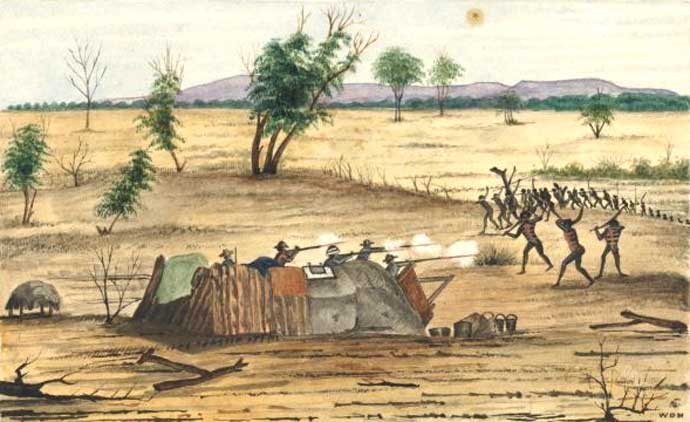
Bulla c1861 conflict Settlers under attack from a First Nations tribe.
(Watercolour by W.O Hodgkinson (National Library of Australia)
Tom O'Lincoln Red Flag 25 January 2015 (edited in 2017)
Across a vast stretch of northern Australia, extending at least from Borroloola to the Kimberley, Aborigines tell the tale of a murderous white man. He stands for whites in general, and is seen as an invader. According to Hobbles Danaiyairi, a Yarralin man in the Northern Territory, quoted in a paper by anthropologist Deborah Bird Rose, he is "shooting all the people [and] getting ready for the country, trying to take it away".
He began in Sydney, progressed to Darwin, later returning to Britain but sending others after him; different versions have him travelling elsewhere, kidnapping or killing the inhabitants. In his greed, violence and dishonesty, this figure represents European law as seen through Indigenous eyes.
Complex societies
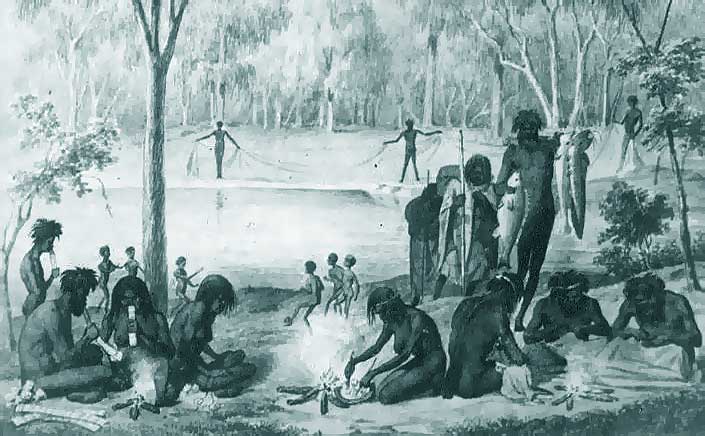
Everyday life of First Nations people before colonisation. This sketch by Wilhelm von Blandowski c1856, where he led an official expedition in the Murray-Darling region
The white settlers had invaded a world quite unlike their own. The people who had inhabited Australia for tens of thousands of years had a different relationship to their physical environment, and different relationships to each other. They lived in relative harmony with the land, plants and animals.
The Indigenous peoples' economies and settlement patterns were diverse. Population densities varied widely, and while some groups survived from seasonal hunting and gathering, their sciences included sustainable agriculture, aquaculture, astronomy and much more.
Along the Murray the Yorta Yorta and others, writes historian Heather Goodall, "had developed such sustained harvesting of the rich fish, game and plants there that they lived virtually sedentary lives in villages which were observed by the earliest white explorers". And on the Darling River "engineering works like the extensive Brewarrina fisheries were constructed to maintain a consistent yield of fish no matter how dry or flooded the rivers might be".
But while the notion that Aborigines did nothing with the land was nonsense, the social context was very different. Association with the land appears to have been more a matter of key sites than the sharp boundaries that white property owners enforced. Whites misunderstood this and took it to imply there was no fixed relationship at all. In reality, social relations were expressed through relations to land, while knowledge and tradition were closely linked to location.
Work was also different. Blacks often worked only until they had enough for their immediate needs, then turned to ritual or social activities that they considered just as important. The capitalist imperative to work and accumulate wealth as ends in themselves did not drive their lives.

First Nations people using clay/earth kilns to cure plants. Sketch by explorer Wilhelm von Blandowski c1849-1859 - Murray Darling region
Social organisation was relatively egalitarian. Some people had special status, and males and females assumed different roles. However, nothing in those customs resembled the entrenched subordination of women typical of European societies, and class divisions were unheard of. Territorial conquest was virtually unknown, since the different groups' ties to specific territories were not conceived in terms of "ownership", let alone capital accumulation.
No wonder the whole idea of some people dominating and exploiting others struck them as irrational and tragic when they encountered it among the whites. They had well-defined identities but no notion of modern nationality or race. Upon deciding, after some initial doubts, that the European settlers were human, they tended to regard them as people like themselves who had developed curious customs and acquired an odd skin colour. They often tried to fit the whites into their kinship systems. It was the invaders who taught them what tragic divisions racism could bring.
Invasion
Early contacts at Sydney Cove seem to have been largely friendly, and there are reports of amicable relations between explorers and Blacks in other parts of the continent. But the locals soon learned that when basic issues were at stake, the whites would use brutal force against them, as the colonial authorities did against their own lower class.
Almost immediately the new arrivals sowed the seeds of conflict, over control and use of the land and the natural environment. The First Fleet having brought only limited supplies, the colonists had to exploit the surrounding landscape. When a party set off to clear the ground to channel water, its leaders noted that "the natives were well pleased with our people until they began clearing the ground at which they were displeased" and that some were enraged at the sight of convicts cutting down trees.
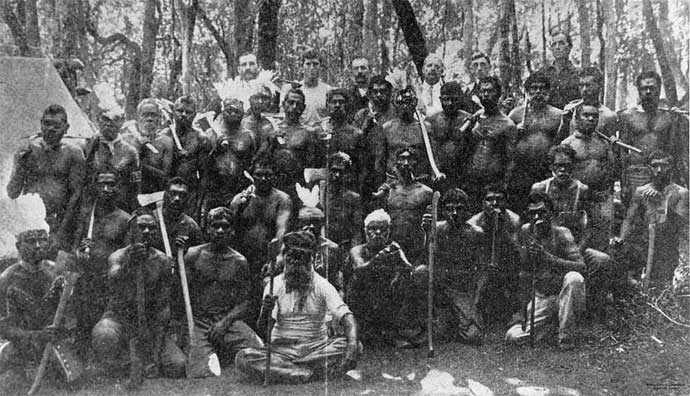
(Picture Queensland, State Library of Queensland)
The locals themselves sometimes cut down trees, for example to make canoes. But they had noticed the whites doing something quite different and seemingly irrational: piling up logs and stones, clearing large tracts, erecting unwieldy structures. It was their first experience of that drive to accumulate wealth that was to transform the continent.
In the early stages, however, the capitalist dynamic of the colony was still uncertain. Officially, it was intended to be no more than a prison with a periphery of small farms, expanding only slowly. The rapid growth of pastoralism and the conquest of the continent were still distant prospects, so relations between Black and white were still ambiguous.
The early governors and other white leaders had hopes of assimilating the Blacks into the new society. In the late 18th and early 19th centuries, Enlightenment philosophy suggested that all races were equally intelligent, with cultural differences stemming from environmental causes. Aborigines might in fact turn out to be Noble Savages (though nevertheless intended for a fairly low rung of the social ladder). Such ideas coexisted with a Christian humanitarianism that appealed to some settlers until it came up against economic self-interest.
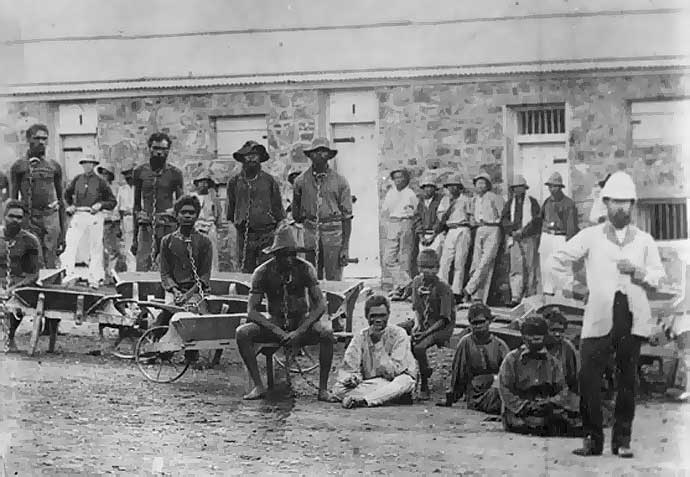
(Battye Library, WA)
Schemes were hatched to bring Blacks into a "civilised" environment; this was the first Stolen Generation. Phillip arranged the kidnapping of five Kooris (including the famous Bennelong), aiming to acquaint them with white ways and use them as intermediaries. In 1789, Lt David Collins wrote of the colonists' mission as "establishing civilisation in the savage world; by animating the children of idleness and vice to habits of laborious and honest industry". Perhaps, some thought, they could be used as wage labourers.
An inevitable conflict
Peaceful coexistence was a fantasy, however, since it presupposed that the original owners should acquiesce in the theft of their land. Collins sounds idiotic, complaining after one clash, "[W]e had not yet been able to reconcile the natives to the deprivation of those parts of this harbour we occupied." Since conflict was inevitable, it was equally inevitable that it should spread since, as Phillip himself recognised, you couldn't crush Black resistance without punishing the innocent along with the "guilty". When the Black warrior Pemulwuy speared Phillip's gamekeeper, the governor ordered punitive expeditions with the aim of infusing "universal terror".
The journal of Watkin Tench (an officer with the First Fleet marines) records that after convicts tried to attack some Aborigines, Phillip ordered the offenders flogged. Arbanoo, one of those kidnapped by the whites, "was present at the infliction of the punishment; and was made to comprehend the cause and the necessity of it; but he displayed on this occasion symptoms of disgust and terror only". Even where the aim was supposedly justice for the Blacks, they were more likely to be repulsed than heartened by the Europeans' grotesque cruelty towards members of their own lower orders.
Vague paternalistic-humanitarian notions and ineffectual attempts at assimilation were undermined by the inherent logic of an invading force seizing territory. Governor Macquarie sometimes recognised that Aboriginal attacks were caused by "provocation or aggression" and hoped that better treatment would soon bring them into "civilisation". To this end, he set up a Native Institution to educate Aboriginal children and allowed a few Blacks to farm.
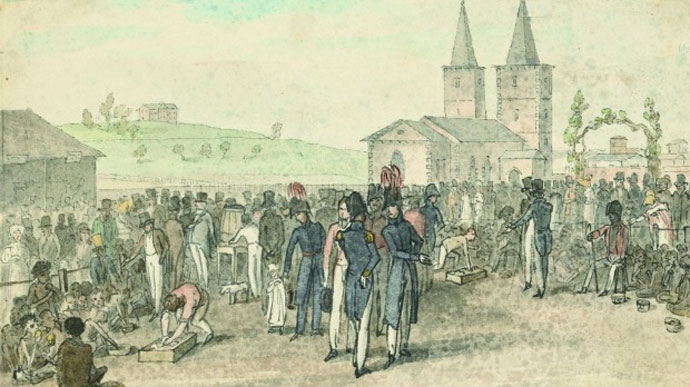
(Augustus Earle, National Library of Australia)
By 1816, after clashes along the Hawkesbury, he was already taking a harder line, issuing a proclamation restricting the groups' freedom of movement and their right to assemble and carry weapons, and even to settle disputes in traditional ways. He followed this up with the first of a series of Aboriginal Congresses, at which he singled out prominent males to become chiefs and paraded the children from the Native Institution.
None of this could work. Even where the authorities sought to restrain white violence, the dispersed nature of settlement frustrated them. The settlers carried guns and didn't hesitate to use them. Moreover, it was not unusual for governors faced with appeals for military support to tell settlers to take matters into their own hands. Macquarie himself announced that if Blacks displayed weapons or refused to leave settlers' properties, they were to be "driven away by force of arms by the settlers themselves".
Where Aborigines of either sex found roles in white society, these were a source of misery and humiliation. Even where they were lent a touch of glamour or prestige, it only served to reinforce the Aborigines' status as curiosities at the social margins, as when John Macarthur rode to a ball at Government House with his Aboriginal bodyguard in gaudy uniforms. Small wonder Blacks drifted away from these roles whenever they were no longer desperate for the economic benefits that went with them.
By the end of the 1820s, Macquarie's Aboriginal Congresses had declined to rump affairs, because the Black populations of the area themselves were in decline as the settlers marched beyond the Sydney region with their livestock, their diseases and their guns. The rapid growth of a capitalist economy after 1820, particularly the pastoral industry driven by British industry's insatiable demand for wool, now began to transform a localised, erratic conflict into a genocidal 100-year war.
Resistance
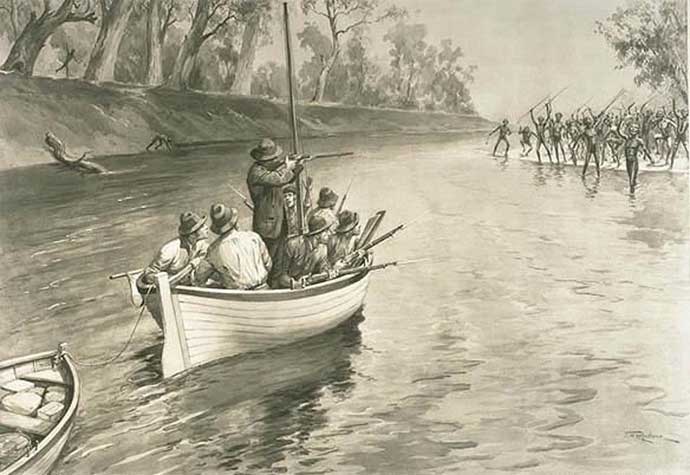
(National Library of Australia picture nla.pic-an9025855-1)
In 1795 the NSW Corps smashed the Darug warriors in a battle near Richmond Hill on the Hawkesbury; two years later they inflicted a major defeat on the Bidjigal at Parramatta. Even so, it was only after the death of Pemulwuy in 1802 that initial instances of serious armed resistance came to an end - and then only in the Sydney area.
When pastoralism took off west of the Blue Mountains, determined resistance by the Wiradjuri people in the Bathurst area forced Governor Brisbane to declare martial law and send extra troops before the Aborigines were beaten in 1824. In the 1820s, fighting also raged along the Hunter River, and by the end of the 1830s a sort of war frontier stretched from northern New South Wales to western Victoria. Shaken by terrible defeats, the Wiradjuri and Gomeroi in this region formed an alliance and used a coordinated strategy against the invader, with some temporary success.
As the Aborigines began to understand the economic basis of white society, they waged economic warfare to undermine it, raiding livestock and attacking loaded drays in an attempt to starve out the more isolated settlements. They targeted horses, having seen how the whites depended on them, and used fire. Pioneers were driven off stations all over the continent at one time or another. Historian Henry Reynolds relates in Frontier that, when Thomas Mitchell was exploring northern NSW in the 1840s, he described one district where "humiliating proofs that the white man had given way were visible in the remains of dairies burnt down, stockyards in ruins, untrodden roads".
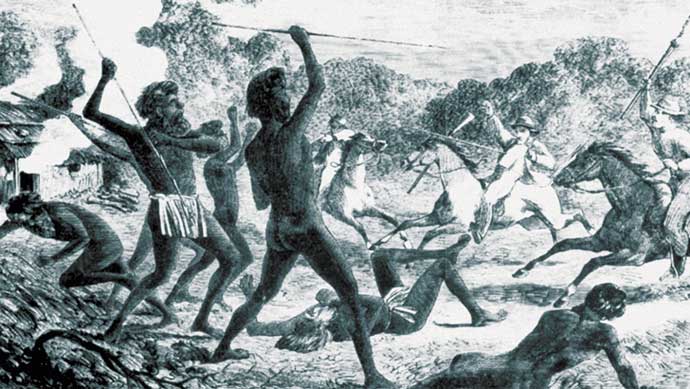
Caption: 'Australian Aborigines - War'.
[Calvert Collection, Mitchell Library, State Library of New South Wales.]
These tactics assisted the Wiradjuri in driving the settlers out of the lower Murrumbidgee (they allowed one friendly white couple to remain) - no small achievement given that half of the local Black population had been wiped out by smallpox some years before. But within two years the white settlers had struck back, using poisoned food and water as well as armed force.
The Aborigines were too fragmented and lacked the technology to win the war, particularly as their numbers began to decline and ever greater numbers of whites arrived on the continent. The last great stand made by Black warriors was that of the Kalkadoons around Mount Isa in the 10 years up to 1884, the year in which they were destroyed by white troops at Battle Mountain.
There is an ongoing debate over whether to call the founding of New South Wales "settlement" or "invasion". Of course it was an invasion; what else do you call seizing someone's country by force? But there is also an organic link between the two aspects, and this is an important part of understanding the killing and the racism. Settlement necessarily meant the violent destruction of traditional Aboriginal society precisely because the conflict was more than a race war. It was also a conflict between two incompatible modes of production and the cultures that accompanied them.
Capitalism could not flourish without crushing the resistance of people who wanted to live differently - that has been true in every corner of the globe. Private property, wage labour and the drive to accumulate capital were incompatible with Aboriginal society. That incompatibility was the basis of the genocide that followed.
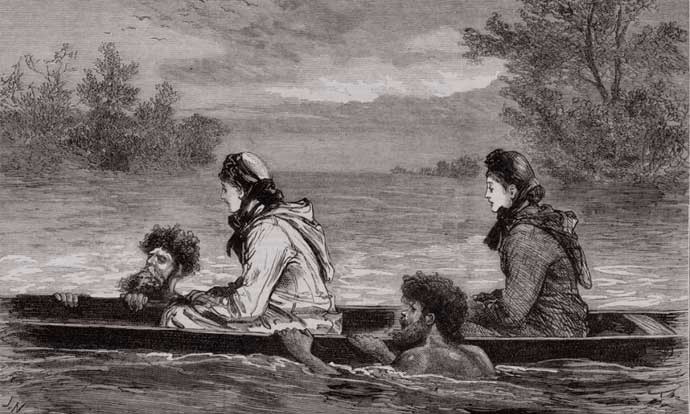
Those surviving the massacres, the First Nations people were used as slaves by the colonisers in all phases of 'settlement', including transportation. c1883
Source:: Culture Victoria

